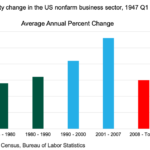We analyzed the Q2 2024 earnings announcements of five large public technology service providers. Big picture, the market is more difficult than in the past decade.
- First, tech service providers continued slow organic growth or decline in Q2 2024, with little change expected for the rest of the year. But bookings are up, which we attribute to enterprise clients’ commitment to core transformations. The disconnect comes from the challenge enterprises face in doing core transformations. What’s needed is value orchestration services to get IT, operations, and business leaders on the same page at the same time.
- Second, every provider is telling an AI story, but there’s a fair amount of AI washing going on, where any project with AI in there somewhere gets labeled as “AI revenue.” With that in mind, it’s important to see AI as a driver of transformation that needs expensive foundations in place to achieve desired benefits.
The story behind the story is that four forces are colliding to drive service provider financial results, and the results are uneven:
- Globally, 60% of IT budgets are allocated to people — both internal staff and outsourced services. Over the past decade, rapid economic growth drove a surge in IT services, as adding more people to solve problems became an efficient approach. With growth slowing, however, companies now have the opportunity to extract greater value from their existing technology investments. The current allocation of 60% toward labor is unsustainable and will need to be addressed. Expect to see automation at scale (enabled by AI/generative AI) become a priority, driving efficiency and creating a deflationary impact on service providers.
- Companies have entered an era of tech absorption after 15 years of tech expansion. Since 2010, we’ve seen double-digit growth in, for example, cloud and software as a service. CFOs at firms of all sizes are asking how this has paid off. The result is a lengthy pause while firms digest what they’ve bought and increase spend for the applications they need to scale (which is why Amazon Web Services, Microsoft Azure, Google Cloud, Salesforce, Workday, and ServiceNow revenues are still growing steadily). This is a structural force pushing transformation bookings up and project bookings down. It could drag on for 5–8 years before a new surge happens.
- We remain in an uncertain economic cycle. Continued high interest rates and economic and political uncertainty have every CFO and board on edge, reluctant to make big investments unless there’s a clear cost takeout or competitive requirement. This is an economic force with a strange consequence: Enterprises are willing to fund large-scale, “build for the future” transformations without having a plan to execute. This reflects the tension between preparing for the future and managing short-term financial risks.
- We are in a short-term AI pause. This force is technological, stemming from the realization that AI enthusiasm has outpaced AI-delivered value. Many companies have been investing in the “dark fiber” of enterprise AI licenses without fully harnessing their potential, but this is a temporary correction. The evidence is accumulating that generative AI will fundamentally reshape businesses operations. In the near term, firms are stepping back to reassess how to extract value from their investments in general-purpose, expert-systems, and task-specific AI copilots (hint: It takes a village.) This will set the stage for future AI spending.
Some providers will ride these forces better than others:
- Providers that stick to old-time and materials business models rather than fixed-price, outcome-aligned, and asset-based pricing models will struggle to compete on the value proposition.
- Providers that focus on skills capacity rather than partnership, alliance, and orchestration skills — what we call co-innovation — will miss out on end-to-end transformation and build/operate/transform/transfer opportunities.
- Providers that resist the cost takeout opportunities presented by AI-powered workflows will be left defending old price structures.
- Providers that continue to see business process outsourcing as a commodity service will miss out on the value-creating future of managed services.








